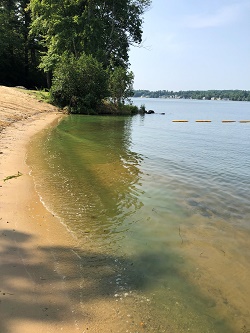Cyanobacteria
Contact
Cyanobacteria Bloom Accumulations and Mats Observed Across Several New Hampshire Lakes

NHDES is following up on several cyanobacteria bloom sightings and reports. Benthic mats of cyanobacteria have also been spotted, floating in coves of certain waterbodies. Please avoid contact with water that appears to be “scummy,” turbid, colorful, globular, or otherwise has flecks or specks that appear concentrated. Cyanobacteria can present a variety of colors and shapes. These organisms may produce toxins that are harmful if ingested, but cyanobacteria cells can also cause skin irritations.
Take a photo and report what you are seeing to the Harmful Algal and Cyanobacterial Bloom Program with NHDES by texting photos to (603) 848-8094 or emailing HAB@des.nh.gov.
“Cyanobacteria Advisories” are issued when samples are collected and identified, with cell concentrations exceeding the state threshold of 70,000 cells/ml.
Current Cyanobacteria Bloom Advisories (sampled weekly since onset of advisory):
• Pelham Town Beach, Long Pond. Issued 8/25.
• Harvey Lake. Issued 8/9.
• Locke Lake, Barnstead. Issued 8/4.
• Marsh Pond, New Durham. Issued 7/21.
• Tucker Pond, Salisbury/Warner. Issued 7/15.
“Cyanobacteria Alerts” are shared when photos and reports have been submitted to NHDES (and no samples have been collected or blooms have already dissipated). Cyanobacteria alerts are shared locally. NHDES has collected several samples across the state and will report any updates as they come in.
Surface Blooms Observed/Alerted:
• Horace Lake, Weare
• Country Pond, Newton/Kingston
• Danforth Ponds, Freedom
• Northwood Lake, Northwood
• Mill Pond, Alton
• Mascoma Lake, Enfield
• Halfmoon Lake, Barnstead
• Lake Kanasatka, Moultonborough
• Silver Lake, Hollis
• Forest Lake, Whitefield
• Angle Pond, Sandown
• Phillips Pond, Sandown
• French Pond, Henniker
• Gloeotrichia-cyanobacteria sightings on Lake Winnipesaukee, Lake Wentworth, Lake Sunapee
Alerts are also shared when observations of benthic mats have been reported. Benthic mats are made up of cyanobacteria that have been growing at the bottom of the lake. Entangled filaments that form a mat may contain a variety of cyanobacteria. The cyanobacteria mats do not represent a bloom in the water column. However, lake-goers are advised to avoid contact with these globs that surface. Please take note of large, dark clumps that may be floating nearshore.
Benthic Mats Reported:
• Chalk Pond, Newbury
• Lily Pond, Barnstead
• Sunset Lake, Hampstead
• Lake Waukeena, Danbury
• Pine River Pond, Wakefield (ongoing local monitoring)
Surface blooms and benthic mats of cyanobacteria can rapidly change and accumulate in various locations around a waterbody. Please continue to monitor your individual shorelines for changing conditions. NHDES advises lake users to avoid contact with the water in areas experiencing elevated cyanobacteria cell conditions. NHDES also advises pet owners to keep their pets out of any waters that have a cyanobacteria bloom. Advisories and alerts are not based on toxin evaluations and are intended as a precautionary measure. These messages are shared to inform the public to be on the lookout, and to be cautious in waterbodies with blooms.
- Visit the NHDES Beach Program website for photos and more information about cyanobacteria.
- View updates on cyanobacteria advisories.
- Follow the Beaches twitter feed.
If you notice anything resembling cyanobacteria, please refrain from wading, swimming, or drinking the water. Keep all pets out of the water and contact NHDES immediately. Please call NHDES to report a cyanobacteria bloom at (603) 848-8094 or email HAB@des.nh.gov.




